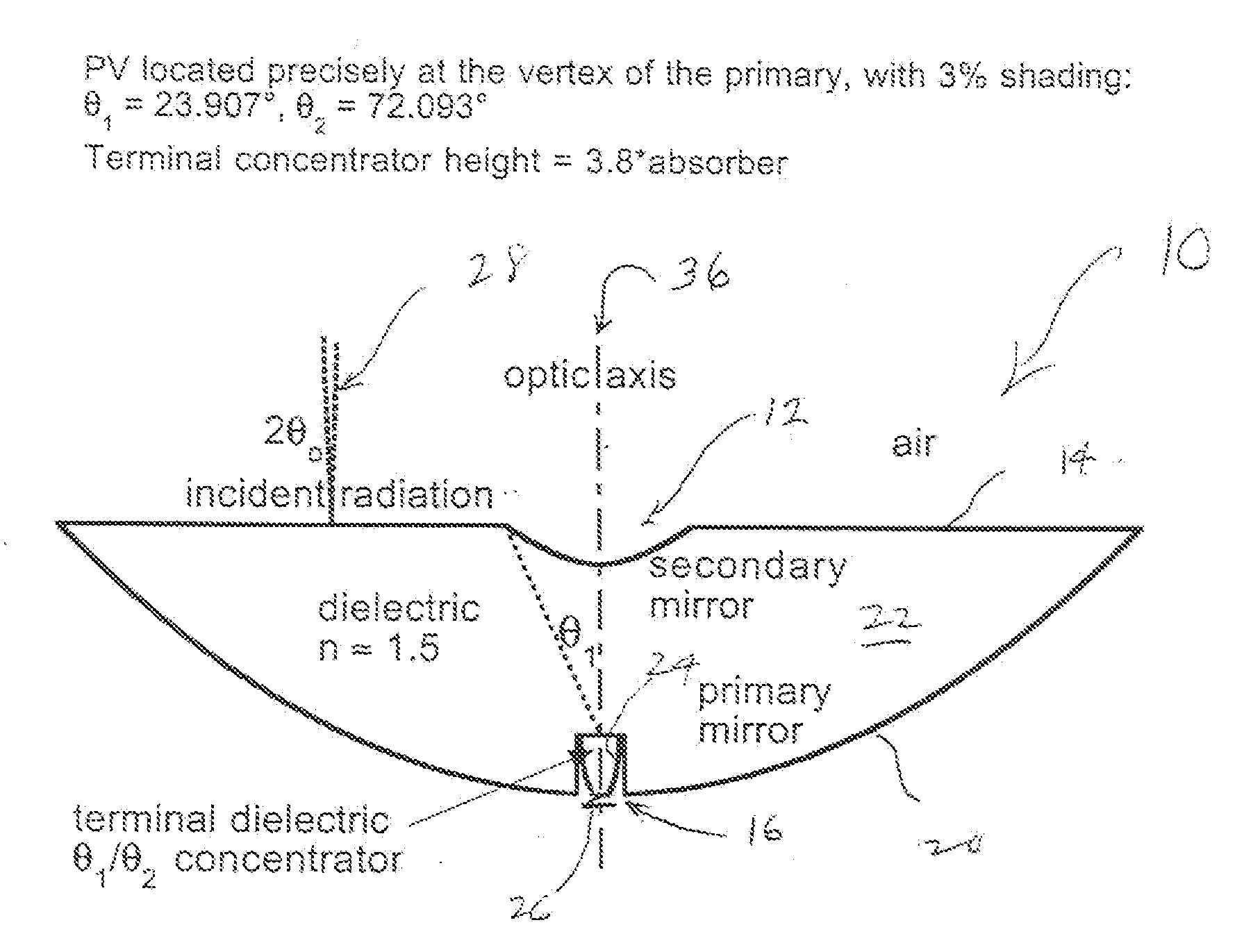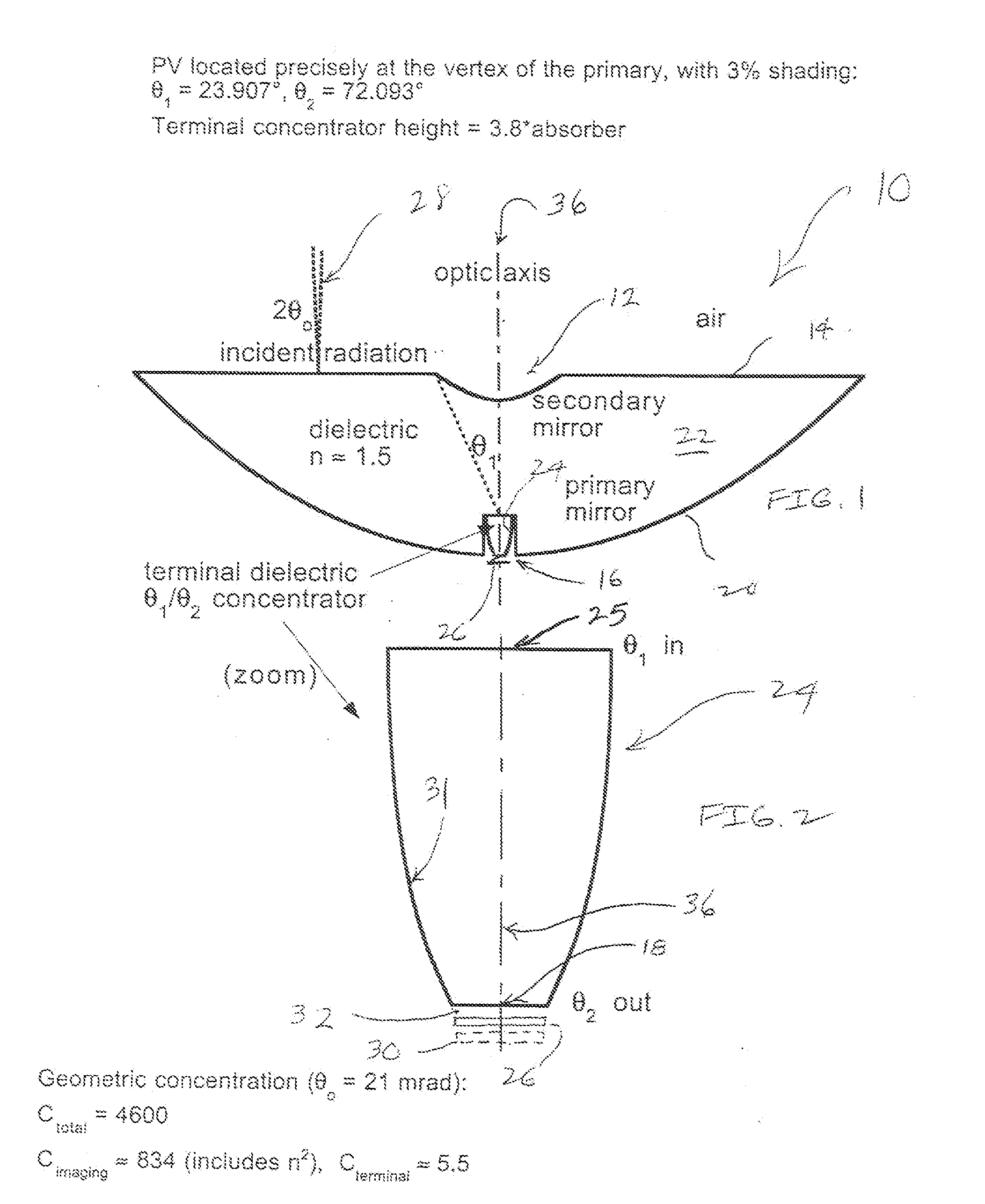Multi-junction solar cells with an aplanatic imaging system and coupled non-imaging light concentrator
a multi-junction solar cell and imaging system technology, applied in the direction of basic electric elements, electrical equipment, semiconductor devices, etc., can solve the problems of limited utility, low cost per kwh, and low cost per kwh, and achieve the effect of increasing the cost of multi-junction cells and increasing the commercial value of multi-junction cells
- Summary
- Abstract
- Description
- Claims
- Application Information
AI Technical Summary
Benefits of technology
Problems solved by technology
Method used
Image
Examples
example 1
[0024]The optical space is filled with the dielectric 22, i.e., the planar non-imaging concentrator 24 resembles a slab of glass. The multi-junction technology lends itself to small solar cell sizes. This size relationship works better since the high current has a shorter distance to travel, mitigating internal resistance effects. Consequently, it is preferable that the cells 26 are in the one to several square mm sizes. The design choice for NA1 has considerable freedom, a trade-off with shading by the secondary mirror 12, but is typically in the range of about 0.3 to 0.4. Taking n.≈1.5, a typical value for glasses (and plastics) we have θc42°. Then from Equation (1), (θ1+θ2)≦96°, we take NA1=0.4n, θ1≈23.5° and θ2 can be as large as 72°, a perfectly reasonable maximum irradiance angle on the multi junction solar cell 26. At the same time, NA2≈0.95n, within 5% of the etendue limit.
example 2
[0025]In another embodiment the non-imaging optical concentrator (or illuminator) is a cylinder with θ1=θ2. The angular restrictions imposed depend on the desired conditions. If TIR is desired and the solar cell is optically coupled to the multi-junction solar cell 26 (or the light source 30 for the illuminator), θ1 should not exceed (90°−θc)≈48°. If TIR is desired and there is a small air gap between the concentrator and the multi-junction solar cell 26 (or the light source 30 for the illuminator), θ1 should not exceed θc≈42°. If the cylinder is silvered and the concentrator is optically coupled to the multi junction solar cell 26 (or the light source 30 for the illuminator) there is no restriction. If the cylinder is silvered and there is a small air gap between the concentrator and the multi-junction solar cell 26 (or the light source 30 for the illuminator), θ1 should not exceed θc≈42°.
example 3
[0026]In another embodiment, radiation is allowed to emerge to accommodate a small air gap between the concentrator and the multi junction solar cell 26 (or the light source 30 for the illuminator), then θ1 should not exceed θc≈42°. Let θ2=39° and θ1=23.5° as before. Then NA2=n sin (39°)=0.94, which is within 6% of the etendue limit.
PUM
 Login to View More
Login to View More Abstract
Description
Claims
Application Information
 Login to View More
Login to View More - R&D
- Intellectual Property
- Life Sciences
- Materials
- Tech Scout
- Unparalleled Data Quality
- Higher Quality Content
- 60% Fewer Hallucinations
Browse by: Latest US Patents, China's latest patents, Technical Efficacy Thesaurus, Application Domain, Technology Topic, Popular Technical Reports.
© 2025 PatSnap. All rights reserved.Legal|Privacy policy|Modern Slavery Act Transparency Statement|Sitemap|About US| Contact US: help@patsnap.com


